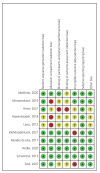The effect of antioxidant supplementation on dysmenorrhea and endometriosis-associated painful symptoms: a systematic review and meta-analysis of randomized clinical trials
- PMID: 38221738
- PMCID: PMC10948216
- DOI: 10.5468/ogs.23210
The effect of antioxidant supplementation on dysmenorrhea and endometriosis-associated painful symptoms: a systematic review and meta-analysis of randomized clinical trials
Abstract
This study aimed to review randomized controlled trials (RCTs) investigating the effects of dietary antioxidant supplements on the severity of endometriosis-related pain symptoms. The PubMed/Medline, Scopus, and Web of Science databases were searched until April 2022. Additionally, we manually searched the reference lists. Endpoints were summarized as standardized mean difference (SMD) with 95% confidence intervals (CIs) in a random-effects model. The I2 statistic was used to assess heterogeneity. Ten RCTs were included in this meta-analysis. Overall, 10 studies were related to dysmenorrhea, four to dyspareunia, and four to pelvic pain. Antioxidants significantly reduced dysmenorrhea (SMD, -0.48; 95% CI, -0.82 to -0.13; I2=75.14%). In a subgroup analysis, a significant reduction of dysmenorrhea was observed only in a subset of trials that administered vitamin D (SMD, -0.59; 95% CI, -1.13 to -0.06; I2=69.59%) and melatonin (SMD, -1.40; 95% CI, -2.47 to -0.32; I2=79.15%). Meta-analysis results also suggested that antioxidant supplementation significantly improved pelvic pain (SMD, -1.51; 95% CI, -2.74 to -0.29; I2=93.96%), although they seem not to have a significant beneficial impact on the severity of dyspareunia. Dietary antioxidant supplementation seems to beneficially impact the severity of endometriosis-related dysmenorrhea (with an emphasis on vitamin D and melatonin) and pelvic pain. However, due to the relatively small sample size and high heterogeneity, the findings should be interpreted cautiously, and the importance of further well-designed clinical studies cannot be overstated.
Keywords: Antioxidant; Dysmenorrhea; Dyspareunia; Endometriosis; Pelvic pain.
Conflict of interest statement
All authors have no conflict of interest to declare.
Figures






Similar articles
-
Vitamin C and E antioxidant supplementation may significantly reduce pain symptoms in endometriosis: A systematic review and meta-analysis of randomized controlled trials.PLoS One. 2024 May 31;19(5):e0301867. doi: 10.1371/journal.pone.0301867. eCollection 2024. PLoS One. 2024. PMID: 38820340 Free PMC article.
-
Dietary Supplements for Endometriosis-Associated Pain: A Systematic Review and Meta-Analysis of Randomized Placebo-Controlled Trials.Gynecol Obstet Invest. 2025 Apr 26:1-14. doi: 10.1159/000545414. Online ahead of print. Gynecol Obstet Invest. 2025. PMID: 40288359 Free PMC article.
-
The impact of vitamin D treatment on pregnancy rate among endometriosis patients: a systematic review and meta-analysis.Ann Med Surg (Lond). 2024 May 15;86(7):4098-4111. doi: 10.1097/MS9.0000000000002174. eCollection 2024 Jul. Ann Med Surg (Lond). 2024. PMID: 38989166 Free PMC article. Review.
-
Vitamin D for primary dysmenorrhea and endometriosis-related pain - A systematic review of registered RCTs.PLoS One. 2025 Apr 21;20(4):e0321393. doi: 10.1371/journal.pone.0321393. eCollection 2025. PLoS One. 2025. PMID: 40257970 Free PMC article.
-
Selective oestrogen receptor modulators (SERMs) for endometriosis.Cochrane Database Syst Rev. 2021 May 11;5(5):CD011169. doi: 10.1002/14651858.CD011169.pub2. Cochrane Database Syst Rev. 2021. PMID: 33973648 Free PMC article.
Cited by
-
Vitamin D and reproductive disorders: a comprehensive review with a focus on endometriosis.Reprod Health. 2024 May 2;21(1):61. doi: 10.1186/s12978-024-01797-y. Reprod Health. 2024. PMID: 38698459 Free PMC article. Review.
-
The effect of antioxidant supplementation on dysmenorrhea and endometriosis-associated painful symptoms: a systematic review and meta-analysis of randomized clinical trials.Obstet Gynecol Sci. 2024 Nov;67(6):586-587. doi: 10.5468/ogs.24228. Epub 2024 Nov 4. Obstet Gynecol Sci. 2024. PMID: 39492638 Free PMC article. No abstract available.
-
Mechanisms of Decidual Dysfunction and Infertility in Endometriosis: Roles of Prostaglandins and SASP.Reprod Med Biol. 2025 Jun 19;24(1):e12663. doi: 10.1002/rmb2.12663. eCollection 2025 Jan-Dec. Reprod Med Biol. 2025. PMID: 40538816 Free PMC article. Review.
-
Endometriosis in Adolescents: A Closer Look at the Pain Characteristics and Atypical Symptoms: A Prospective Cohort Study.J Clin Med. 2025 Feb 19;14(4):1392. doi: 10.3390/jcm14041392. J Clin Med. 2025. PMID: 40004922 Free PMC article.
References
-
- Gordts S, Koninckx P, Brosens I. Pathogenesis of deep endometriosis. Fertil Steril. 2017;108:872–85e1. - PubMed
-
- Johnson NP, Hummelshoj L, Adamson GD, Keckstein J, Taylor HS, Abrao MS, et al. World Endometriosis Society consensus on the classification of endometriosis. Hum Reprod. 2017;32:315–24. - PubMed
-
- Chapron C, Marcellin L, Borghese B, Santulli P. Rethinking mechanisms, diagnosis and management of endometriosis. Nat Rev Endocrinol. 2019;15:666–82. - PubMed
LinkOut - more resources
Full Text Sources
Miscellaneous

